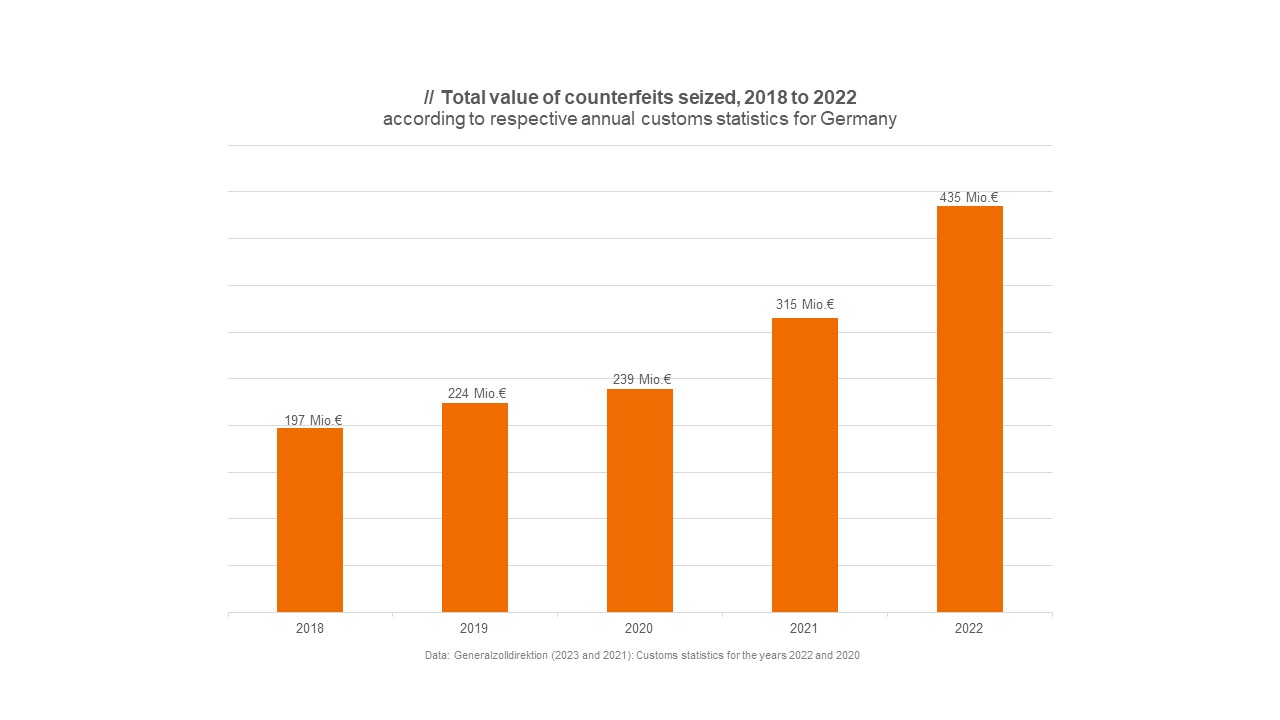Last year, German customs officials seized a total of over 434 million euros worth of counterfeits – an alarming increase of almost 40% compared to the previous year. At the same time, the quantity of seized goods is declining: While 2021 saw around 18.8 million counterfeits seized, German customs reported around 8.6 million seized counterfeits for 2022. This is according to the new annual customs statistics for 2022 (Zolljahresstatistik 2022), which were presented in May 2023 by German Finance Minister Christian Lindner and the President of the General Directorate of Customs, Colette Hercher.

The increase in the seizure value is particularly marked in the area of pharmaceuticals, for example: In 2021, such counterfeit medicine products with a value of around one million euros were removed from circulation; in 2022, this figure has increased almost tenfold to 9.6 million euros. In addition, the seizure values in the categories of personal care products, tobacco products, and footwear increased too. The highest overall seizure value, as in 2021, was again for goods in the personal accessories category, which includes products such as sunglasses, bags, watches, and jewelry. For 2022, customs recorded a seizure value of around 280 million euros for these products – the already high value in 2021 has thus been doubled once again.
While the value of the intercepted counterfeits often increased significantly, a different picture emerges with respect to the quantity of seized goods. Looking at the different categories of goods, it is apparent that the quantity of intercepted goods declined in many categories. Only for some industries did the quantities of seized goods increase, for example in the sectors of clothing and accessories, food and beverages, and footwear.
As in 2021, the People’s Republic of China was again the prevalent country of origin of counterfeit goods in 2022. Some 80% of the counterfeit goods seized came from China, based on the quantity of seized goods. Second place, with 8% of the seized goods, went to the Chinese special administrative region of Hong Kong. Other important countries of origin included Turkey with around 5%, as well as Taiwan, Vietnam, and Ukraine, each with around 2% of the total quantity of seized items.

When it comes to the transport routes of seized goods, sea freight remains as clearly the largest contributor, with a slight decrease, from around 86% in 2021 to around 80% in 2022 (by quantity of seized goods). However, it is worth noting that the second most important transport route for counterfeits, air freight shipments, has almost doubled year‑on‑year, to around 12% in terms of the quantity of counterfeit goods seized. Looking at the value of seizures, however, air freight shipments contributed over 75% and are even more clearly in first place than in the previous year (around 60% in 2021).
 Among the intellectual property rights infringed by the seized products, the share of infringements of trademark rights rose to around 91% (2021 at around 86%). By contrast, the second-largest share, design infringements, fell to 6% (still at around 12% in 2021). Infringements of protected geographical indications (around 3%) and copyrights (0.05%), by comparison, played a rather minor role, as they did in 2020 and 2021. Infringements against utility models, plant variety protection, and trade names even fell to 0%.
Among the intellectual property rights infringed by the seized products, the share of infringements of trademark rights rose to around 91% (2021 at around 86%). By contrast, the second-largest share, design infringements, fell to 6% (still at around 12% in 2021). Infringements of protected geographical indications (around 3%) and copyrights (0.05%), by comparison, played a rather minor role, as they did in 2020 and 2021. Infringements against utility models, plant variety protection, and trade names even fell to 0%.
The President of the General Directorate of Customs, Colette Hercher, thanked the approximately 48,000 customs employees for their commitment. The work of customs in Europe is also in focus with current reform plans of the European Union, which could also have an impact on the fight against counterfeiting.




